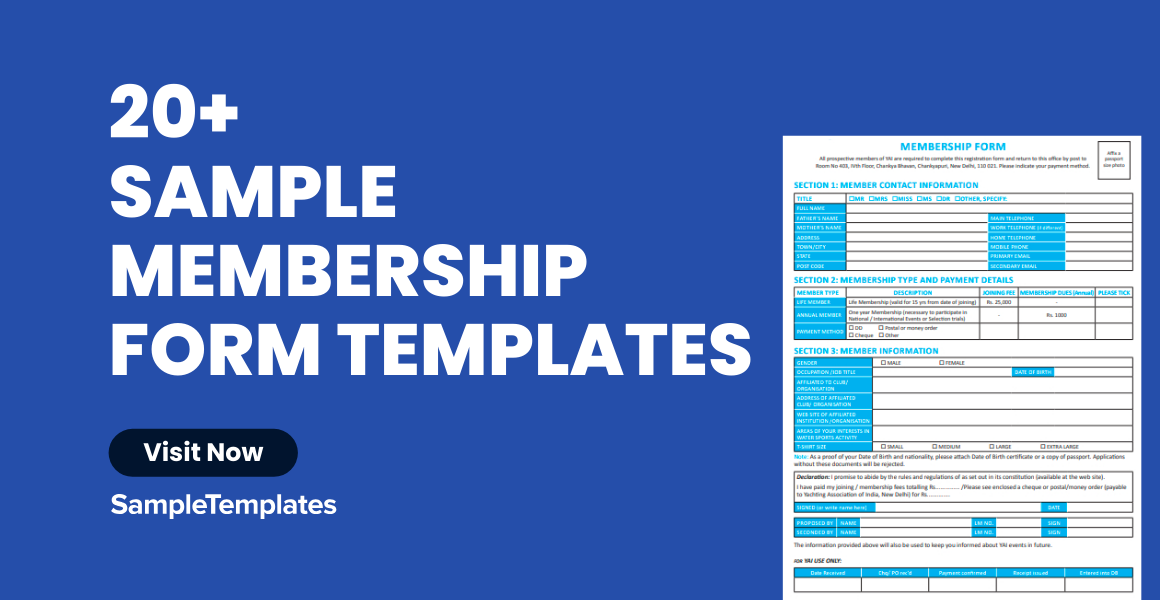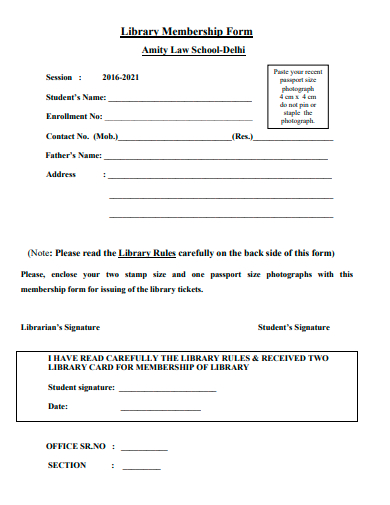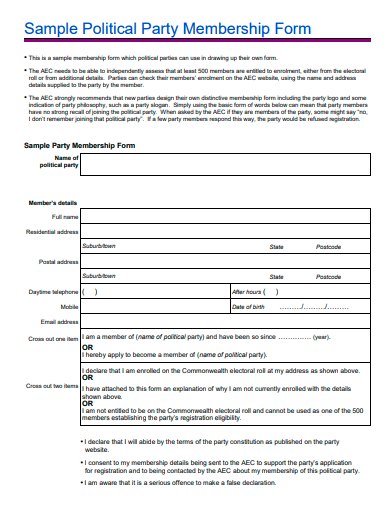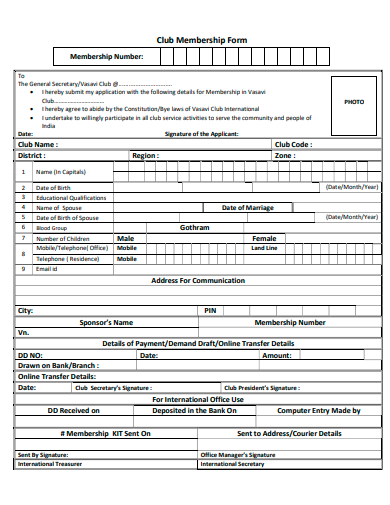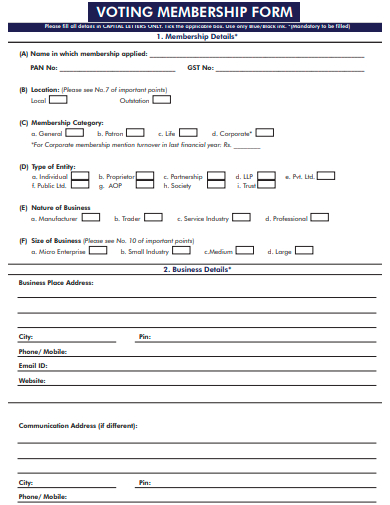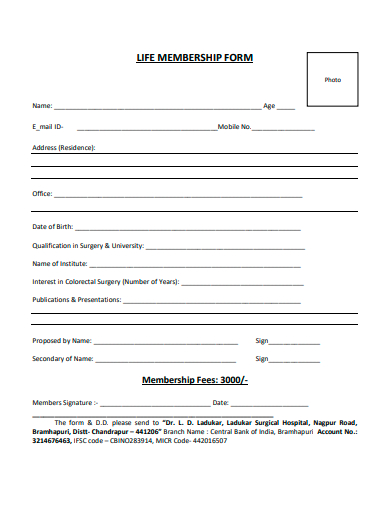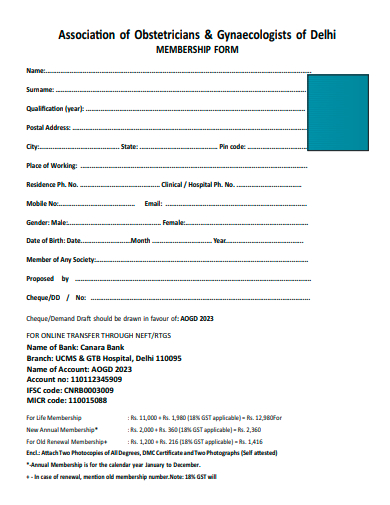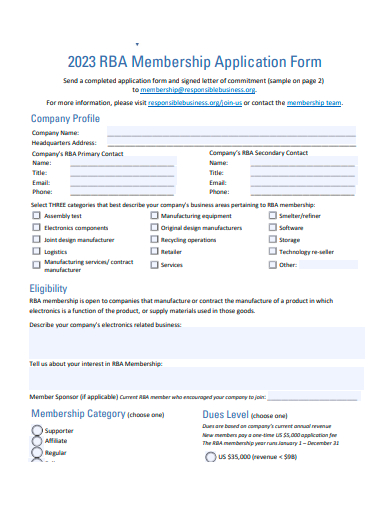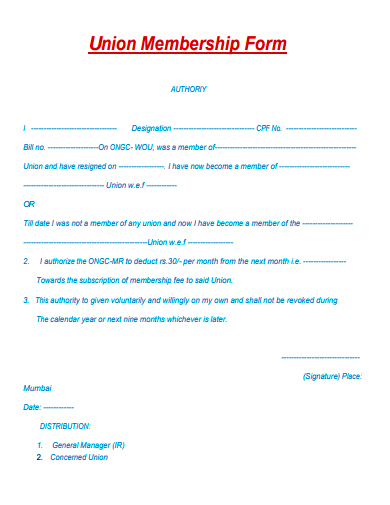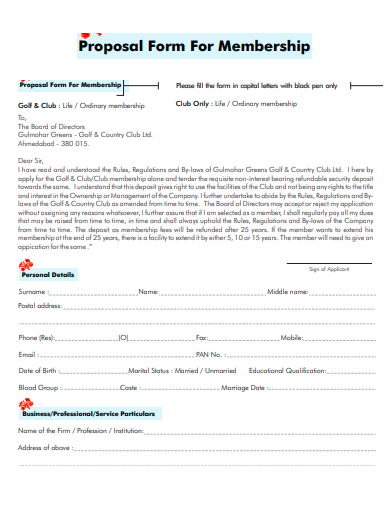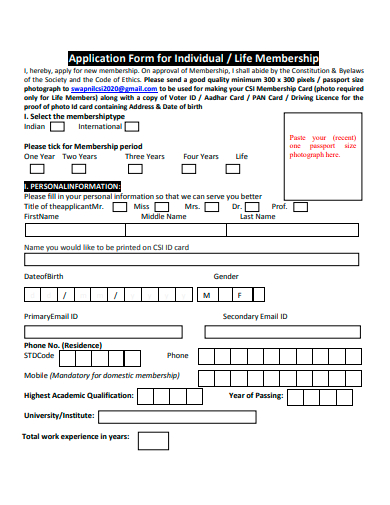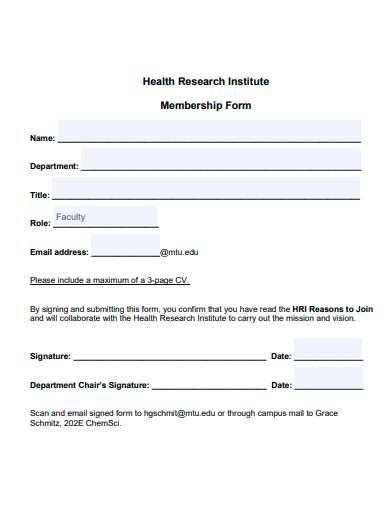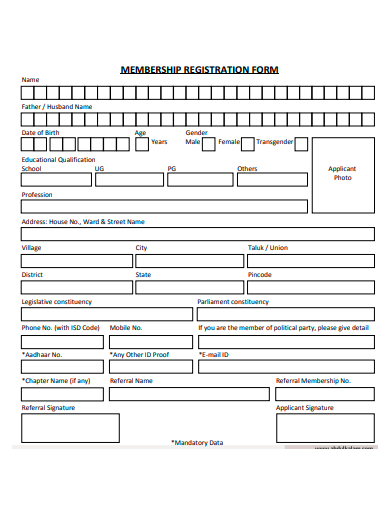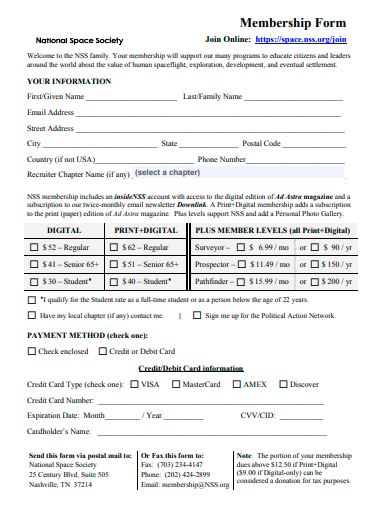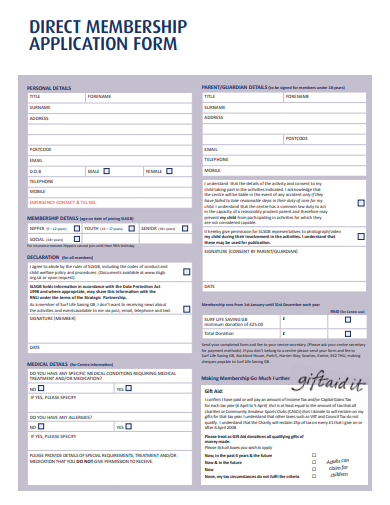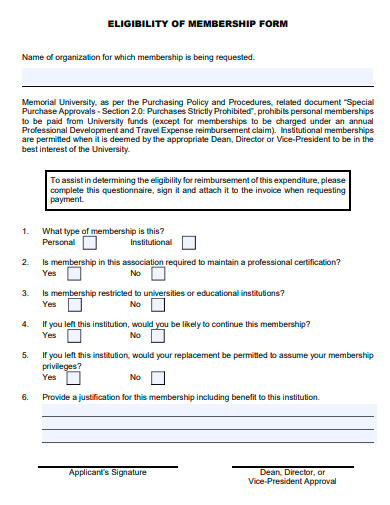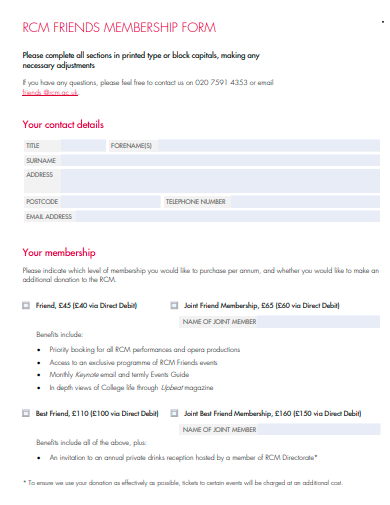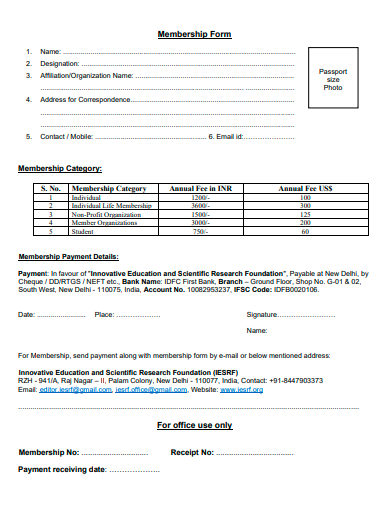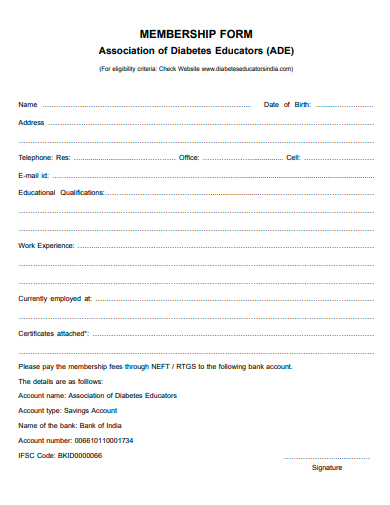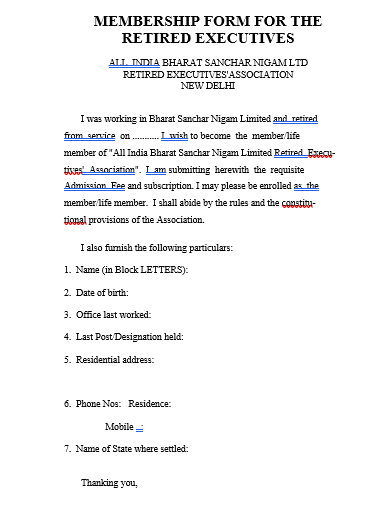Unlock the potential of efficient member onboarding with our Sample Membership Form Template. Crafted for today’s dynamic organizations, this template refines the registration form process, ensuring precision in capturing vital details. Ideal for communities, clubs, or online platforms, our template emphasizes a user-centric approach while being SEO-optimized. Experience a seamless and transformative member registration process now!
20+ Membership Form Samples
1. Membership Form Template
2. Sample Library Membership Form Template
3. Official Membership Application Form Template
4. Sample Political Party Membership Form Template
What is a Membership Form?
A membership form is a document or digital tool designed to capture specific information from individuals who wish to join an organization, club, group, or service. This sample form acts as a bridge between an entity and a potential member, gathering crucial details that support the decision-making process, aid in efficient onboarding, and lay the foundation for future communication.
Significance of a Membership Form:
Information Collection: Membership forms offer an organized method to amass vital details. These can range from personal information and contact details to preferences and other data pertinent to the organization. Having a structured record for each member is invaluable for effective communication, event planning, and informed decision-making.
Streamlined Onboarding: With a comprehensive membership form, organizations can guarantee a smooth entry process for new members. Whether it involves dispatching welcome packages, sharing orientation specifics, or granting access to exclusive resources, the details provided in the form simplify these tasks.
Setting Expectations: Membership forms can incorporate terms, conditions, or codes of conduct. By doing so, they ensure members know what is expected of them and vice versa, cultivating a foundation built on mutual respect and clarity.
Components of a Membership Form:
Membership forms can vary, adapting to the unique needs of different organizations. However, they often share several standard elements:
- Personal Details: This encompasses elements like the applicant’s name, date of birth, and other personal identifiers.
- Contact Information: Key for effective communication, this section requests the member’s email address, phone number, and residential address.
- Membership Type or Category: In organizations with varied membership levels, this section enables applicants to indicate their preferred tier or category.
- Payment Details: If there’s a membership fee, this section will cover payment methods and frequency, be it annual, monthly, or another interval.
- Preferences: Here, members can indicate choices such as newsletter subscriptions, event participation, or volunteering opportunities.
- Terms and Conditions: This section provides space for applicants to acknowledge they’ve comprehended and accepted the organization’s terms and code of conduct.
- Signature: Traditional forms usually have a space for the applicant’s signature, whereas digital forms might employ checkboxes or e-signature functionalities.
The Digital Shift:
The contemporary era, dominated by digital interactions, has seen a significant shift from traditional paper-based membership forms to online versions. Online forms come with a plethora of benefits: immediate data collection, seamless database integration, convenience in distribution, and an eco-friendly footprint. Moreover, digital forms can be designed to adapt dynamically, altering sections based on user inputs, offering a more tailored experience.
Membership forms, be they on paper or in a digital format, are pivotal in crafting the bond between an organization and its community. They serve multiple essential functions, from data collection to setting clear expectations. As entities and their goals evolve, it becomes paramount to ensure that these forms are regularly reviewed and updated to remain efficient and pertinent.
5. Club Membership Form Template
6. Voting Membership Form Template
7. Life Membership Form Template
8. Basic Membership Form Template
How to Create a Membership Form
Creating a membership form is a fundamental step for organizations, clubs, or groups aiming to streamline the process of accepting new members. An effective membership form should be simple to understand, easy to fill out, and capable of capturing all the necessary information. Here’s a step-by-step guide to help you create a compelling membership form:
Define the Purpose:
Before you begin designing your form, pinpoint its purpose. Are you aiming to enroll members for a community club, an online course, or perhaps a premium content platform? Understanding the end goal ensures that you create a form that captures the exact data you need.
Choose a Platform:
Depending on your resources and needs, you can go for traditional paper forms or digital ones. Digital forms are more environmentally friendly, can easily be shared via email or on websites, and offer instant data collection. Tools like Google Forms, Typeform, and JotForm make the creation process straightforward.
Design with User Experience in Mind:
Ensure the form is user-friendly. It should be organized with clear sections, legible fonts, and intuitive navigation. For digital forms, make sure they are mobile-responsive, as many users might access them via smartphones.
Essential Information First:
Begin with the basics: name, email, phone number, and address. These are usually the fundamental details you’ll need from every member.
Tailor to Your Needs:
Depending on your organization’s nature, you might require specific details such as membership type, preferred communication method, areas of interest, or qualifications. Ensure that these fields are customized to capture the unique data pertinent to your group.
Integrate Conditional Logic (For Digital Forms):
If you’re using an online form builder, leverage its conditional logic features. This allows for dynamic form alterations based on user responses. For instance, if a user indicates interest in volunteering, subsequent questions could delve deeper into availability and specific skills.
Privacy and Consent:
If you’ll be storing personal data, it’s crucial to include a section that outlines your data usage policy and ensures GDPR compliance (or equivalent data protection laws in your jurisdiction). Also, consider including a consent checkbox where members acknowledge and agree to your terms.
Keep It Concise:
While it’s tempting to gather as much information as possible, try to limit your form to essential questions only. Lengthy forms can deter potential members from completing the process.
Test the Form:
Before official deployment, test the form. For digital forms, fill it out using different devices to ensure compatibility. For paper forms, have a few people go through it to check clarity and comprehensibility.
Distribute and Review:
Share the form with your target audience. For digital forms, this could be through your website, social media channels, or email campaigns. For physical forms, distribution might occur at events, meetings, or community centers. Regularly review the responses and feedback to refine and optimize your form over time.
Creating a membership form is more than just about collecting data. It’s about offering a seamless and positive experience for potential members right from the outset. A well-designed form not only aids in efficient data collection but also reflects the professionalism and values of the organization it represents.
9. Membership Application Form Template
10. Sample Union Membership Form Template
11. Membership Proposal Form Template
12. Individual Membership Application Form Template
13. Printable Membership Form Template
Advantages of Membership Forms
Membership forms, while simple in appearance, play a pivotal role in the organizational framework of clubs, societies, and groups. Their advantages touch upon various facets of administration, member engagement, and organizational growth.
Structured Data Collection:
Membership forms present a systematic method to gather essential data from potential members. This organized approach ensures that the data collected remains consistent, easing the processes of management, analysis, and subsequent utilization.
Efficient Onboarding:
With a comprehensive membership form in place, the process of integrating new members into an organization becomes more streamlined. Access to resources, events, or benefits becomes quicker when all necessary information is at hand.
Enhanced Communication:
Membership forms collect contact details and individual communication preferences. This data paves the way for organizations to fine-tune their communication strategies, sending out tailored emails, newsletters, or event notifications that resonate with each member’s interests.
Demographic Insights:
By capturing details such as age, location, profession, and more, membership forms offer a peek into the demographic layout of an organization’s member base. These insights can guide strategies and offerings to better align with the audience.
Resource Allocation:
Understanding the specific requirements and preferences of members helps in judicious resource allocation. For instance, if a large segment of members shows a leaning towards certain workshops, organizations can prioritize them.
Feedback Mechanism:
Membership forms often come equipped with sections dedicated to feedback or suggestions. Such inputs can be invaluable, granting organizations a direct line to the pulse of their community, and aiding in adaptive improvements.
Security and Privacy:
Especially in digital formats, membership forms can incorporate mechanisms that ensure data security and privacy. Such measures instill a sense of trust and confidence among members regarding the safety of their information.
Legal and Compliance Benefits:
Many forms include segments where members agree to specific terms or codes of conduct. Such inclusions help set expectations and can act as a protective legal layer for the organization.
Financial Planning:
For organizations with varied membership tiers or those that charge fees, membership forms can assist in predicting financial influx, leading to better budgeting and financial preparedness.
Building Community:
Membership forms indirectly assist in community building. By gaining insights into member profiles and preferences, organizations can nurture a sense of belonging and ensure that all members feel acknowledged and valued.
The humble membership form, often taken for granted, offers a slew of advantages that ripple through an organization’s operations. By leveraging these benefits, organizations can enjoy smoother operations, enriched member engagement, and sustained growth.
14. Membership Registration Form Template
15. Sample Membership Form Template
16. Direct Membership Application Form Template
17. Eligibility Membership Form Template
18. Sample Friends Membership Form Template
19. Formal Membership Form Template
20. Simple Membership Form Template
21. Membership Form in DOC
What Should Be Included in a Membership Form?
A membership form serves as a crucial tool for organizations, clubs, or groups, streamlining the process of accepting and managing members. An effective form captures relevant data without overwhelming the respondent, striking a balance between necessity and brevity. Let’s delve into the essential components of a well-crafted membership form:
Personal and Contact Information:
At the foundation of every membership form lies the collection of basic personal details. This typically encompasses:
- Full name
- Date of birth
- Gender or preferred pronoun
- Email address
- Phone number
- Residential address
Membership Type or Category:
If your organization offers different levels or types of memberships, it’s essential to provide options for applicants to indicate their preferred category, such as ‘Standard’, ‘Premium’, ‘Student’, ‘Senior’, etc.
Occupation and Qualifications:
For organizations like professional associations, understanding a member’s educational background, occupation, or professional qualifications might be pertinent. This can help tailor communications or offerings to their specific profession or level of expertise.
Payment Information:
- If there’s a membership fee, you’ll need sections dedicated to:
- Fee amount (possibly varying by membership type)
- Preferred payment method (credit card, bank transfer, etc.)
- Payment frequency (monthly, annually)
Areas of Interest or Preferences:
To make communications and activities more relevant, it’s useful to know members’ specific interests related to the organization’s offerings. For instance, if it’s a sports club, options could range from ‘Tennis’ to ‘Swimming’ or ‘Group Fitness Classes’.
Terms, Conditions, and Privacy Policies:
It’s crucial to include clauses that outline the organization’s terms of membership, code of conduct, and privacy policies. Members should have a space to acknowledge that they’ve read, understood, and accepted these conditions.
Feedback or Suggestions:
Including an optional section for feedback or comments can offer valuable insights. New members might have fresh perspectives or ideas that can benefit the organization.
Emergency Contact Details:
Especially relevant for organizations that conduct physical events, activities, or meetings. Knowing whom to contact in case of emergencies is vital for member safety.
Photographic Consent:
If the organization plans to capture photographs during events or activities for promotional purposes, it’s good practice to seek consent from members to use their images.
Signature and Date:
Physical forms should have a space for applicants to sign and date, acknowledging the accuracy of the information provided and agreement to the terms. Digital forms can incorporate e-signature functionalities or checkboxes for the same purpose.
Crafting a membership form is a thoughtful process, demanding a balance between collecting essential information and ensuring user-friendliness. While the specifics might vary based on an organization’s unique needs, the core objective remains the same: to create a seamless and efficient onboarding process that lays the foundation for a fruitful relationship between the member and the organization.
Related Posts
Sample Sworn Affidavit Forms
Vehicle Inspection Forms Samples & Templates
Sample Employee Advance Forms
Sample Child Travel Consent Forms
Sample Testimonial Request Forms
Sample Employee Details Forms
Sample Divorce Forms
Sample Attestation Forms
Employee Performance Appraisal Form Templates
FREE 9+ Sample Presentation Evaluation Forms in MS Word
FREE 10+ School Admission Form Samples & Templates in MS Word | PDF
FREE 30+ Patient Consent Form Samples in PDF | MS Word
FREE 10+ Sample Sign Off Form Templates in PDF | MS Word
FREE 11+ Sample Medical Consultation Forms in PDF | MS Word
FREE 8+ Sample Donation Forms in PDF | MS Word
